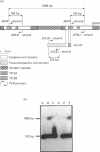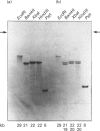Abstract
To date five human mucin cDNAs (MUC2, 5A, 5B, 5C and 6) mapped to 11p15.3-15.5, so it appears that this chromosome region might contain several distinct gene loci for mucins. Three of these cDNAs, MUC5A, B and C, were cloned in our laboratory and previously published. A common number, 5, was recommended by the Human Gene Mapping Nomenclature Committee to designate them because of their common provenance from human tracheobronchial mucosa. In order to define whether they are products of the same gene locus or distinct loci, we describe in this paper physical mapping of these cDNAs using the strategy of analysis of CpG islands by pulse-field gel electrophoresis. The data suggest that MUC5A and MUC5C are part of the same gene (called MUC5AC) which is distinct from MUC5B. In the second part of this work, complete sequences of the inserts corresponding to previously described (JER47, JER58) and novel (JER62, JUL32, MAR2, MAR10 and MAR11) cDNAs of the so-called MUC5AC gene are presented and analysed. The data show that in this mucin gene, the tandem repeat domain is interrupted several times with a subdomain encoding a 130 amino acid cysteine-rich peptide in which the TR3A and TR3B peptides previously isolated by Rose et al. [Rose, Kaufman and Martin (1989) J. Biol. Chem., 264, 8193-8199] from airway mucins are found. A consensus peptide sequence for these subdomains involving invariant positions of most of the cysteines is proposed. The consensus nucleotide sequence of this subdomain is also found in the MUC2 gene and in the MUC5B gene, two other mucin genes mapped to 11p15. The functional significance for secreted mucins of these cysteine-rich subdomains and the modular organization of mucin peptides are discussed.
Full text
PDF








Images in this article
Selected References
These references are in PubMed. This may not be the complete list of references from this article.
- Aubert J. P., Porchet N., Crepin M., Duterque-Coquillaud M., Vergnes G., Mazzuca M., Debuire B., Petitprez D., Degand P. Evidence for different human tracheobronchial mucin peptides deduced from nucleotide cDNA sequences. Am J Respir Cell Mol Biol. 1991 Aug;5(2):178–185. doi: 10.1165/ajrcmb/5.2.178. [DOI] [PubMed] [Google Scholar]
- Audie J. P., Janin A., Porchet N., Copin M. C., Gosselin B., Aubert J. P. Expression of human mucin genes in respiratory, digestive, and reproductive tracts ascertained by in situ hybridization. J Histochem Cytochem. 1993 Oct;41(10):1479–1485. doi: 10.1177/41.10.8245407. [DOI] [PubMed] [Google Scholar]
- Bhargava A. K., Woitach J. T., Davidson E. A., Bhavanandan V. P. Cloning and cDNA sequence of a bovine submaxillary gland mucin-like protein containing two distinct domains. Proc Natl Acad Sci U S A. 1990 Sep;87(17):6798–6802. doi: 10.1073/pnas.87.17.6798. [DOI] [PMC free article] [PubMed] [Google Scholar]
- Bickmore W. A., Bird A. P. Use of restriction endonucleases to detect and isolate genes from mammalian cells. Methods Enzymol. 1992;216:224–244. doi: 10.1016/0076-6879(92)16024-e. [DOI] [PubMed] [Google Scholar]
- Bird A. P. CpG-rich islands and the function of DNA methylation. Nature. 1986 May 15;321(6067):209–213. doi: 10.1038/321209a0. [DOI] [PubMed] [Google Scholar]
- Bobek L. A., Tsai H., Biesbrock A. R., Levine M. J. Molecular cloning, sequence, and specificity of expression of the gene encoding the low molecular weight human salivary mucin (MUC7). J Biol Chem. 1993 Sep 25;268(27):20563–20569. [PubMed] [Google Scholar]
- Brown W. R., Bird A. P. Long-range restriction site mapping of mammalian genomic DNA. 1986 Jul 31-Aug 6Nature. 322(6078):477–481. doi: 10.1038/322477a0. [DOI] [PubMed] [Google Scholar]
- Crepin M., Porchet N., Aubert J. P., Degand P. Diversity of the peptide moiety of human airway mucins. Biorheology. 1990;27(3-4):471–484. doi: 10.3233/bir-1990-273-426. [DOI] [PubMed] [Google Scholar]
- Daopin S., Cohen G. H., Davies D. Response. Science. 1992 Nov 13;258(5085):1161–1162. doi: 10.1126/science.258.5085.1161. [DOI] [PubMed] [Google Scholar]
- Devine P. L., McKenzie I. F. Mucins: structure, function, and associations with malignancy. Bioessays. 1992 Sep;14(9):619–625. doi: 10.1002/bies.950140909. [DOI] [PubMed] [Google Scholar]
- Dufosse J., Porchet N., Audie J. P., Guyonnet Duperat V., Laine A., Van-Seuningen I., Marrakchi S., Degand P., Aubert J. P. Degenerate 87-base-pair tandem repeats create hydrophilic/hydrophobic alternating domains in human mucin peptides mapped to 11p15. Biochem J. 1993 Jul 15;293(Pt 2):329–337. doi: 10.1042/bj2930329. [DOI] [PMC free article] [PubMed] [Google Scholar]
- Eckhardt A. E., Timpte C. S., Abernethy J. L., Zhao Y., Hill R. L. Porcine submaxillary mucin contains a cystine-rich, carboxyl-terminal domain in addition to a highly repetitive, glycosylated domain. J Biol Chem. 1991 May 25;266(15):9678–9686. [PubMed] [Google Scholar]
- Fox M. F., Lahbib F., Pratt W., Attwood J., Gum J., Kim Y., Swallow D. M. Regional localization of the intestinal mucin gene MUC3 to chromosome 7q22. Ann Hum Genet. 1992 Oct;56(Pt 4):281–287. doi: 10.1111/j.1469-1809.1992.tb01154.x. [DOI] [PubMed] [Google Scholar]
- Gardiner K., Horisberger M., Kraus J., Tantravahi U., Korenberg J., Rao V., Reddy S., Patterson D. Analysis of human chromosome 21: correlation of physical and cytogenetic maps; gene and CpG island distributions. EMBO J. 1990 Jan;9(1):25–34. doi: 10.1002/j.1460-2075.1990.tb08076.x. [DOI] [PMC free article] [PubMed] [Google Scholar]
- Gardiner K. Pulsed field gel electrophoresis and investigations into mammalian genome organization. J Cell Sci. 1990 May;96(Pt 1):5–8. doi: 10.1242/jcs.96.1.5. [DOI] [PubMed] [Google Scholar]
- Garfinkel M. D., Pruitt R. E., Meyerowitz E. M. DNA sequences, gene regulation and modular protein evolution in the Drosophila 68C glue gene cluster. J Mol Biol. 1983 Aug 25;168(4):765–789. doi: 10.1016/s0022-2836(83)80074-6. [DOI] [PubMed] [Google Scholar]
- Gendler S., Taylor-Papadimitriou J., Duhig T., Rothbard J., Burchell J. A highly immunogenic region of a human polymorphic epithelial mucin expressed by carcinomas is made up of tandem repeats. J Biol Chem. 1988 Sep 15;263(26):12820–12823. [PubMed] [Google Scholar]
- Gerard C., Eddy R. L., Jr, Shows T. B. The core polypeptide of cystic fibrosis tracheal mucin contains a tandem repeat structure. Evidence for a common mucin in airway and gastrointestinal tissue. J Clin Invest. 1990 Dec;86(6):1921–1927. doi: 10.1172/JCI114925. [DOI] [PMC free article] [PubMed] [Google Scholar]
- Griffiths B., Matthews D. J., West L., Attwood J., Povey S., Swallow D. M., Gum J. R., Kim Y. S. Assignment of the polymorphic intestinal mucin gene (MUC2) to chromosome 11p15. Ann Hum Genet. 1990 Oct;54(Pt 4):277–285. doi: 10.1111/j.1469-1809.1990.tb00383.x. [DOI] [PubMed] [Google Scholar]
- Gross M. S., Guyonnet-Duperat V., Porchet N., Bernheim A., Aubert J. P., Nguyen V. C. Mucin 4 (MUC4) gene: regional assignment (3q29) and RFLP analysis. Ann Genet. 1992;35(1):21–26. [PubMed] [Google Scholar]
- Gum J. R., Byrd J. C., Hicks J. W., Toribara N. W., Lamport D. T., Kim Y. S. Molecular cloning of human intestinal mucin cDNAs. Sequence analysis and evidence for genetic polymorphism. J Biol Chem. 1989 Apr 15;264(11):6480–6487. [PubMed] [Google Scholar]
- Gum J. R., Hicks J. W., Swallow D. M., Lagace R. L., Byrd J. C., Lamport D. T., Siddiki B., Kim Y. S. Molecular cloning of cDNAs derived from a novel human intestinal mucin gene. Biochem Biophys Res Commun. 1990 Aug 31;171(1):407–415. doi: 10.1016/0006-291x(90)91408-k. [DOI] [PubMed] [Google Scholar]
- Gum J. R., Jr, Hicks J. W., Toribara N. W., Rothe E. M., Lagace R. E., Kim Y. S. The human MUC2 intestinal mucin has cysteine-rich subdomains located both upstream and downstream of its central repetitive region. J Biol Chem. 1992 Oct 25;267(30):21375–21383. [PubMed] [Google Scholar]
- Gum J. R., Jr, Hicks J. W., Toribara N. W., Siddiki B., Kim Y. S. Molecular cloning of human intestinal mucin (MUC2) cDNA. Identification of the amino terminus and overall sequence similarity to prepro-von Willebrand factor. J Biol Chem. 1994 Jan 28;269(4):2440–2446. [PubMed] [Google Scholar]
- Gum J. R., Jr Mucin genes and the proteins they encode: structure, diversity, and regulation. Am J Respir Cell Mol Biol. 1992 Dec;7(6):557–564. doi: 10.1165/ajrcmb/7.6.557. [DOI] [PubMed] [Google Scholar]
- Jany B. H., Gallup M. W., Yan P. S., Gum J. R., Kim Y. S., Basbaum C. B. Human bronchus and intestine express the same mucin gene. J Clin Invest. 1991 Jan;87(1):77–82. doi: 10.1172/JCI115004. [DOI] [PMC free article] [PubMed] [Google Scholar]
- Lamblin G., Degand P., Roussel P., Havez R., Hartemann E., Fillat M. Les glycopeptides du mucus bronchique fibrillaire dans la mucoviscidose. Clin Chim Acta. 1972 Feb;36(2):329–340. doi: 10.1016/0009-8981(72)90006-x. [DOI] [PubMed] [Google Scholar]
- Lan M. S., Batra S. K., Qi W. N., Metzgar R. S., Hollingsworth M. A. Cloning and sequencing of a human pancreatic tumor mucin cDNA. J Biol Chem. 1990 Sep 5;265(25):15294–15299. [PubMed] [Google Scholar]
- Larsen F., Gundersen G., Prydz H. Choice of enzymes for mapping based on CpG islands in the human genome. Genet Anal Tech Appl. 1992 Jun;9(3):80–85. doi: 10.1016/1050-3862(92)90002-m. [DOI] [PubMed] [Google Scholar]
- Lindsay S., Bird A. P. Use of restriction enzymes to detect potential gene sequences in mammalian DNA. 1987 May 28-Jun 3Nature. 327(6120):336–338. doi: 10.1038/327336a0. [DOI] [PubMed] [Google Scholar]
- Meezaman D., Charles P., Daskal E., Polymeropoulos M. H., Martin B. M., Rose M. C. Cloning and analysis of cDNA encoding a major airway glycoprotein, human tracheobronchial mucin (MUC5). J Biol Chem. 1994 Apr 29;269(17):12932–12939. [PubMed] [Google Scholar]
- Meindl A., Berger W., Meitinger T., van de Pol D., Achatz H., Dörner C., Haasemann M., Hellebrand H., Gal A., Cremers F. Norrie disease is caused by mutations in an extracellular protein resembling C-terminal globular domain of mucins. Nat Genet. 1992 Oct;2(2):139–143. doi: 10.1038/ng1092-139. [DOI] [PubMed] [Google Scholar]
- Meitinger T., Meindl A., Bork P., Rost B., Sander C., Haasemann M., Murken J. Molecular modelling of the Norrie disease protein predicts a cystine knot growth factor tertiary structure. Nat Genet. 1993 Dec;5(4):376–380. doi: 10.1038/ng1293-376. [DOI] [PubMed] [Google Scholar]
- Nguyen V. C., Aubert J. P., Gross M. S., Porchet N., Degand P., Frézal J. Assignment of human tracheobronchial mucin gene(s) to 11p15 and a tracheobronchial mucin-related sequence to chromosome 13. Hum Genet. 1990 Dec;86(2):167–172. doi: 10.1007/BF00197699. [DOI] [PubMed] [Google Scholar]
- Porchet N., Nguyen V. C., Dufosse J., Audie J. P., Guyonnet-Duperat V., Gross M. S., Denis C., Degand P., Bernheim A., Aubert J. P. Molecular cloning and chromosomal localization of a novel human tracheo-bronchial mucin cDNA containing tandemly repeated sequences of 48 base pairs. Biochem Biophys Res Commun. 1991 Mar 15;175(2):414–422. doi: 10.1016/0006-291x(91)91580-6. [DOI] [PubMed] [Google Scholar]
- Probst J. C., Gertzen E. M., Hoffmann W. An integumentary mucin (FIM-B.1) from Xenopus laevis homologous with von Willebrand factor. Biochemistry. 1990 Jul 3;29(26):6240–6244. doi: 10.1021/bi00478a018. [DOI] [PubMed] [Google Scholar]
- Rose M. C., Kaufman B., Martin B. M. Proteolytic fragmentation and peptide mapping of human carboxyamidomethylated tracheobronchial mucin. J Biol Chem. 1989 May 15;264(14):8193–8199. [PubMed] [Google Scholar]
- Rothberg J. M., Artavanis-Tsakonas S. Modularity of the slit protein. Characterization of a conserved carboxy-terminal sequence in secreted proteins and a motif implicated in extracellular protein interactions. J Mol Biol. 1992 Sep 20;227(2):367–370. doi: 10.1016/0022-2836(92)90891-m. [DOI] [PubMed] [Google Scholar]
- Siddiqui J., Abe M., Hayes D., Shani E., Yunis E., Kufe D. Isolation and sequencing of a cDNA coding for the human DF3 breast carcinoma-associated antigen. Proc Natl Acad Sci U S A. 1988 Apr;85(7):2320–2323. doi: 10.1073/pnas.85.7.2320. [DOI] [PMC free article] [PubMed] [Google Scholar]
- Swallow D. M., Gendler S., Griffiths B., Kearney A., Povey S., Sheer D., Palmer R. W., Taylor-Papadimitriou J. The hypervariable gene locus PUM, which codes for the tumour associated epithelial mucins, is located on chromosome 1, within the region 1q21-24. Ann Hum Genet. 1987 Oct;51(Pt 4):289–294. doi: 10.1111/j.1469-1809.1987.tb01063.x. [DOI] [PubMed] [Google Scholar]
- Toribara N. W., Roberton A. M., Ho S. B., Kuo W. L., Gum E., Hicks J. W., Gum J. R., Jr, Byrd J. C., Siddiki B., Kim Y. S. Human gastric mucin. Identification of a unique species by expression cloning. J Biol Chem. 1993 Mar 15;268(8):5879–5885. [PubMed] [Google Scholar]
- Xu G., Huan L. J., Khatri I. A., Wang D., Bennick A., Fahim R. E., Forstner G. G., Forstner J. F. cDNA for the carboxyl-terminal region of a rat intestinal mucin-like peptide. J Biol Chem. 1992 Mar 15;267(8):5401–5407. [PubMed] [Google Scholar]






